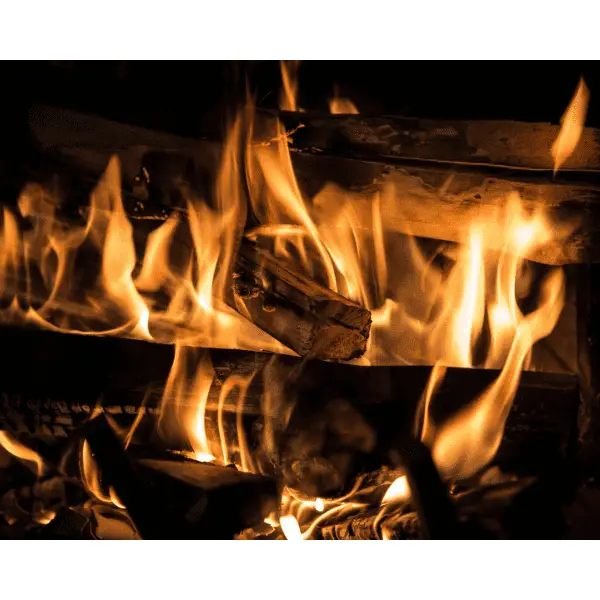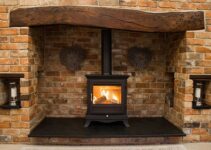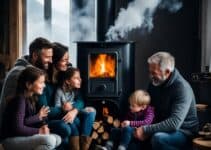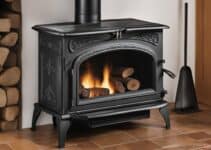On a cold winter’s night, there’s nothing better than curling up in front of a log burner with a glass of something equally warming. Wood burners not only make a beautiful addition to the home, but they are also efficient at heating it too.
And with the costs of fuel and cost of living rising rather startlingly, wood burners are a great way to cut energy costs.
But perhaps you have acquired a model that is more enclosed and hasn’t got a very large glass door and you want to see the flames. Or perhaps, you feel like the burner provides more heat with the door open.
Either way, you’re left with the question: Can I leave my log burner door open? And the answer is, yes, you can but you probably shouldn’t.
Can I Leave the Door Open on my Wood Burning Stove?
Many people ask if they can leave the door open on their wood burning stove. And the most straightforward answer is, yes, you can leave the door open on your log burner. And many people do from time to time.
But while it might be nice to have direct sight of flames dancing on your logs, it is the least efficient use of your stove.
Not only this, but the microparticles that are emitted from open fires and log burners with the doors open enter the living space and can cause respiratory problems.
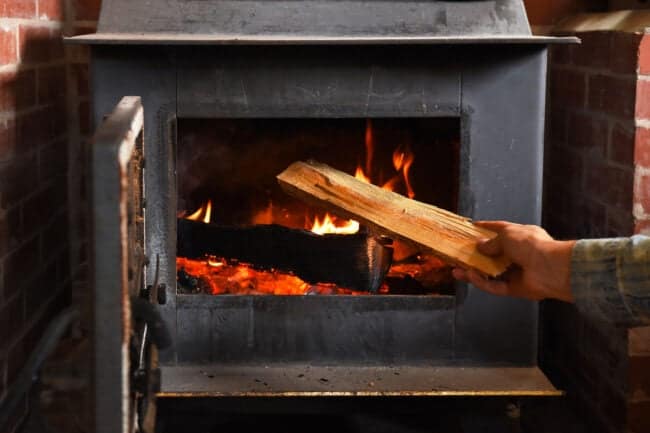
Should You Have the Door Open on a Log Burner?
So we’ve established that homeowners can leave their log burner door open. But the reality is you really shouldn’t. And there is a range of reasons why.
Reduces Efficiency
Wood burning stoves were designed to control the combustion of the heat within the firebox. By enclosing the fire less heat escapes making the stove far more efficient than a traditional open fireplace.
This is likely the reason that so many people have chosen to replace their fireplaces with a wood burning stove.
By leaving the stove door open you are interrupting the proper functioning of the log burner making it up to 60% less efficient.
This is because with uncontrolled access to oxygen in the room your logs will burn more quickly and most of this heat will escape up your flue and into the atmosphere.
The design concept of a wood burning stove is centred around creating heat in the most efficient way possible.
And this is achieved by sealing the atmosphere and controlling the air intake through the vents. The heat is then transferred into the metal stove frame and this radiates into the room in a controlled way.
And if your stove is modern, the gases that would normally be expelled up the chimney, are used as a secondary fuel source which provides a secondary source of heat.
So, by opening the door, you lose control of the controlled combustion happening in the firebox, and thus, the heat.
Increases Costs
Opening the door of your log burner may appear to provide more heat. And part of that is due to increasing the flame on your logs.
But this actually means you are merely speeding up the combustion process.
Rather than being the most efficient use of your fuel, you will instead burn through it at a quicker rate which will cost more in the long run.
Not only this, you’ll be losing the controlled distribution of heat through the stove frame and most of your heat will go up the flue!
So, if you installed your stove to cut costs, leaving the door to your log burner open is not the best way to save money.
Increases Health Risks
Scientists have known for a while that there are health risks associated with both open fires and with log burners when the door is open.
Those most at risk are the elderly and very young and the most common complaints are respiratory problems or dryness and irritability of the skin.
These health risks are due to the microparticles that wood gives off when it is burned. In log burners, when their doors are left open during cleaning or refuelling, these tiny particles can waft back into the room.
If you use well-seasoned wood the reduction in these particles is significant but there is still a risk. In fact, a recent government-funded report showed that log burners were the cause of 40% of outdoor tiny particle pollution.
And while many modern stoves are installed with filters, these only reduce the fine particle pollution going outside.
So, to minimise the risk of spikes of particles entering your living space, you should keep the log burner door closed as much as possible.
Is a Log Burner Hotter with Door Open?
With the log burner doors open, you’re allowing more oxygen into the firebox and you’ll see an increase in the flame on your logs.
This may appear to give off more heat and, in a sense, it does because you are increasing the rate of combustion. In the short term, you may experience greater radiant heat from your stove.
But this doesn’t mean the heat produced is hotter in the long term, nor does it mean you’ll get a warmer room.
By leaving the door open, you won’t give the stove a chance to do its job properly which is storing and radiating that heat out into the room over time. And, as previously mentioned, it’s the least effective use of your log burner, reducing its efficiency and energy-saving potential by over a half.
Why Does My Wood Burner Smoke When I Open the Door?
Wood burners may smoke for a number of reasons. Some of those reasons are potentially more of a cause for concern than others.
One reason that your wood burning stove may produce smoke is if there is a sudden down draft of air from the wind. While this may cause an extra influx of small particle pollution into the home, it’s not much more of a problem than normal.
If the log burner smokes regularly, it might indicate a wider problem with the chimney’s ability to draw. And this could be for a number of reasons including a blockage or partial blockage of the chimney.
It could also suggest a structural problem with the chimney itself.
Another possible reason is that you may be burning inappropriate fuel. For wood or log burners, it’s essential for the longevity of your stove, the efficacy of your burner, the well-being of your family and to protect the environment, that you use well-seasoned wood.
Test the moisture content of your logs with a digital wood moisture tester. These can be picked up relatively cheaply and will ensure that your wood has reached optimal moisture content for burning.
This is between 10% – 20%.
Your insurers probably insist on your log burner being checked at least annually. This is not only a safety precaution that protects your home and assets but also makes sure your log burner is working efficiently.
But if you have problems with a smoking stove and you have crossed off all of the reasons above, you may need to get an extra service to see if there is an issue with the parts within the stove itself.
And whether your stove is smoking or not, always make sure you instal a smoke and methane detector in the room in which the stove is sited for extra safety.
Does a Fireplace Burn Better with the Doors Open or Closed?
The term fireplace is traditionally used to describe the place in which a fire is situated. The term is mostly linked to a traditional open fireplace rather than a wood burning stove or log burner.
Fireplaces, therefore, don’t have doors. They are open to the room and can either have a hearth or stove placed within the fireplace.
If by ‘fireplace’, you mean a log burner or wood burning stove then we can answer that question.
If by ‘better’ you mean more efficiently then there is no doubt that firmly closing the doors of your log burner is far better than leaving them open for all of the reasons mentioned previously.
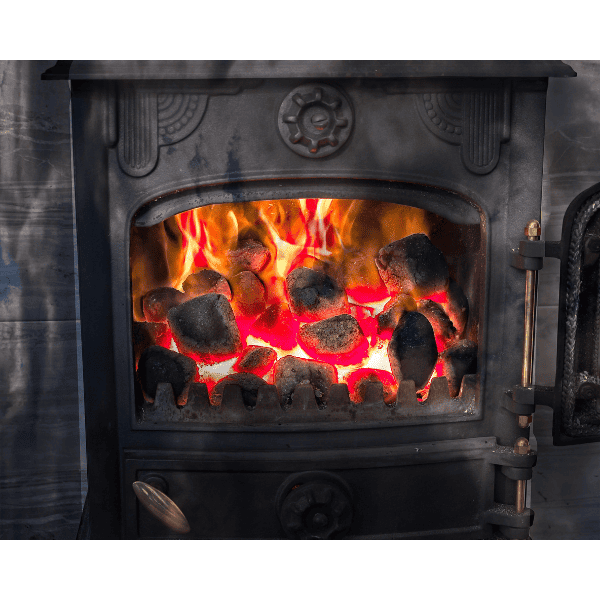
Log Burner Goes Out When the Door is Closed – Why is This?
The air vents in your stove are your method to control the airflow into the firebox of your wood burning stove. And this is how you control the flame within.
If the air vents aren’t sufficiently open, you’ll cut off the air supply that’s needed to keep the logs alight.
Different fuel burns in different ways, depending on a number of factors, so you could start by changing the flow of air through the vents to find the best position for your batch of logs.
Another reason may be a lack of ventilation in the room, meaning there’s not enough oxygen to feed the flames. Open a window to see if that makes a difference.
If none of those tactics work, there may be a problem with the stove or flue. And in these cases, we’d always recommend calling for an expert assessment.
Don’t be fooled by flames. Leaving your burner or stove door open might give you the experience a cheery feel but it’s not what they were designed for.
Save yourself money and time, and protect your family’s health by keeping the door on your log burner shut as much as possible.
